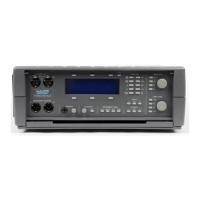channel. The frequency of the driven channel is also measured to
determine the proper frequency for the bandpass filter.
The upper left section of the display shows the crosstalk reading, which
is the amplitude of the non-driven channel. The upper left soft key
selects the display units. The usual absolute and relative amplitude
units are available, plus ‘dB’, which displays the amplitude difference,
in decibels, between the driven channel and the non-driven channel.
The upper center section of the display shows the amplitude of the
alternate channel. Pressing the upper center soft key selects among the
usual absolute and relative amplitude units.
The upper right section of the display shows the frequency of the
alternate (driven) channel. This frequency is used to tune the
bandpass filter. The upper right soft key turns the reading on or off.
Pressing the INPUT A button will select input A for the main
(non-driven) channel, and input B for the alternate (driven) channel. It
will also turn generator channel B on and channel A off. Pressing the
INPUT B button will select input B for the main (non-driven) channel,
and input A for the alternate (driven) channel. It will also turn
generator channel A on and channel B off.
Gen-mon is not provided in the XTALK function.
The signal on the driven channel must be at least 8 mV and the THD
less than about 10% for proper functioning of the frequency counter
for bandpass tuning. If it is not, both the XTALK reading and the
frequency reading will read ‘Low’.
No fixed filters are available.
& For more
information on
amplitude units, see
page 4-71.
4 Operation
Operation Controlling the Analyzer : XTALK (Crosstalk)
4-52 Portable One Plus Access User's Manual
Artisan Technology Group - Quality Instrumentation ... Guaranteed | (888) 88-SOURCE | www.artisantg.com

